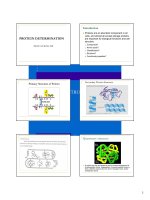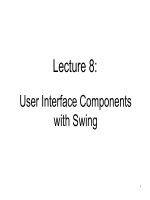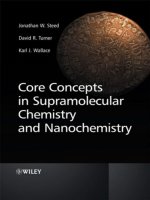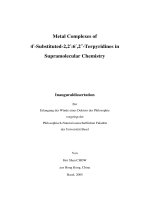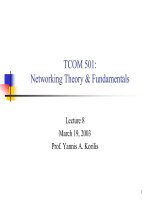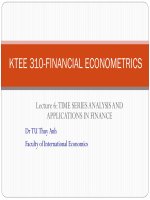Lecture 8 supramolecular chemistry
Bạn đang xem bản rút gọn của tài liệu. Xem và tải ngay bản đầy đủ của tài liệu tại đây (2.4 MB, 46 trang )
Nanochemistry
NAN 601
Instructor:
Dr.
Marinella Sandros
Lecture 8: Supramolecular Chemistr
1
“Supramolecular chemistry is the chemistry of the
intermolecular bond, covering the structures and
functions of the entities formed by the association
of two or more chemical species”
J.-M- Lehn
"Supramolecular chemistry is defined as
chemistry
‘beyond the Molecule’, as chemistry of tailor
shaped inter-molecular interaction.”
F. Vögtle
/>
“Chemistry beyond the molecule”
“Chemistry of molecular assemblies and of
the intermolecular bond.”
“The Chemistry of non-covalent bond.”
3
Supramolecular chemistry involves investigating
molecular systems in which the most important
feature is that components are held together by
intermolecular forces, not by covalent bonds.
Covalent Interactions
Atoms
Molecules
Molecules
Non-Covalent Interactions
Supermolecules
4
5
/>
Where did it come from?
Inspired from biology and built on the
shoulders of traditional synthetic organic
chemistry.
Why does it deserve to be a field of study all
its own?
The next logical step in synthetic chemistry;
understanding and interface with the
biological world; nanotechnology
6
/>
/>
/>
Lock and Key Principle
/>
Molecular Self-Assembly:
Process by which 2 or more molecules
interact from a larger structure or
organization.
Super-Molecule:
A complex formed by molecular selfassembly which contains a discrete number
of subunits.
11
/>
/>
13
14
/>
/>
/>
/>
/>
The
study of non-covalent interactions
is crucial to understanding many
biological processes from cell structure
to vision that rely on these forces for
structure and function. Biological
systems are often the inspiration for
supramolecular research.
/>
21
/>
people.bio.aau.dk/.../PowerPoint/Supramolecular%20chemistry.ppt
malina.ichf.edu.pl/educ/.../WYKLAD_SUPRA_NANO1_2005.ppt
24
/>
